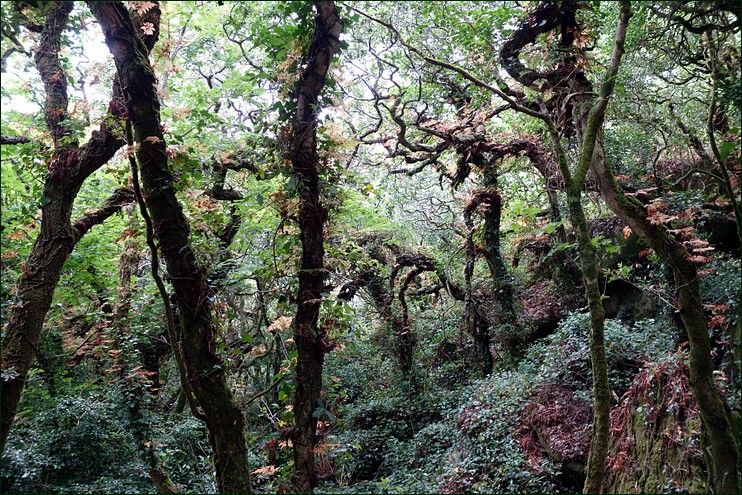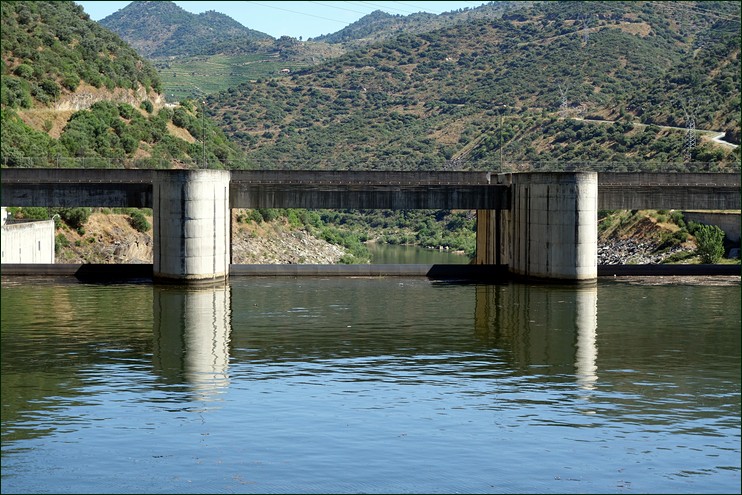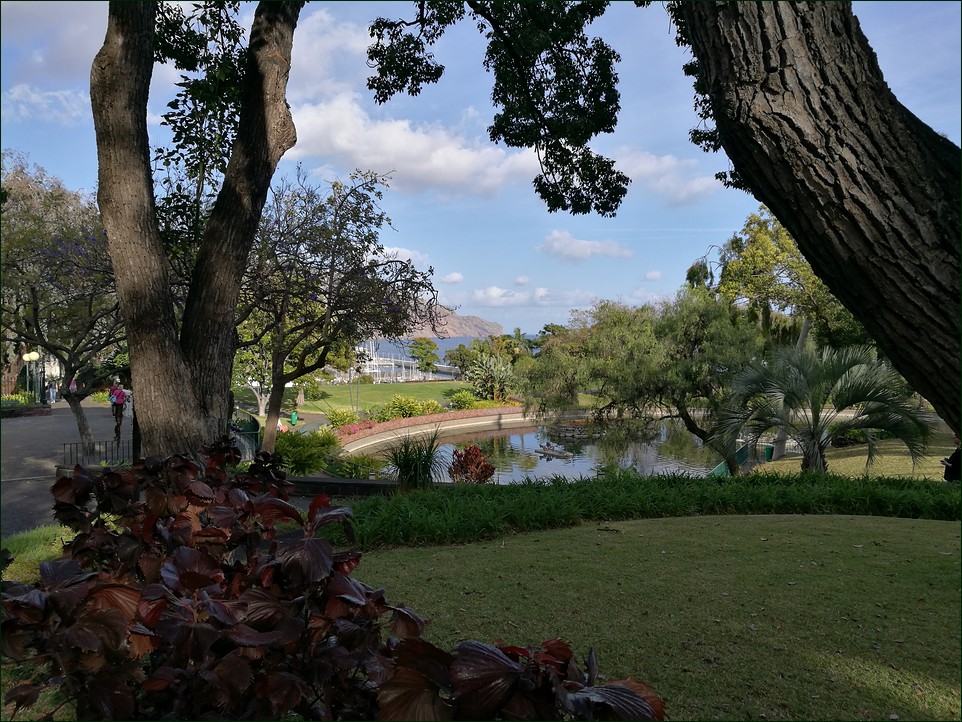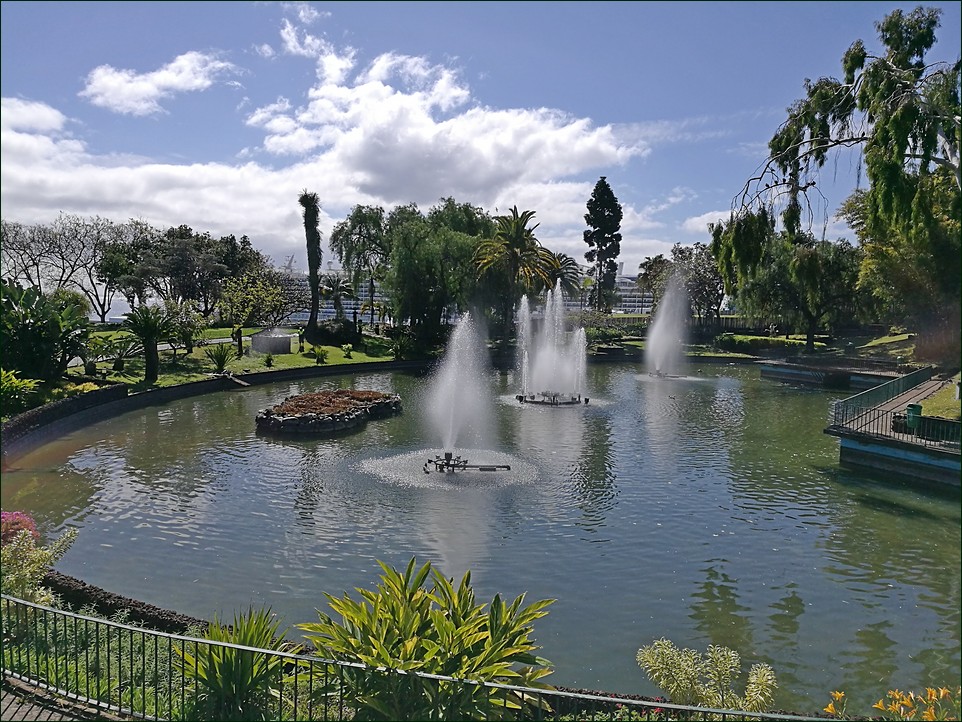Some Places To Enjoy Life... In Portugal and Madeira
It didn't take us long to fall in love with Portugal and with its very friendly people. The cost of living is low, and the Portuguese really care about their environment, with almost 100% of their energy needs coming from renewables.
The Portuguese have a special relationship with the English, stemming from the old alliance between our two countries (the oldest such alliance in the world that is still in force).
We fell completely in love with Portugal's island of Madeira on our second visit to that island. This was intended to be for a few weeks, but we were stranded there for nearly 4 months due to the COVID-19 pandemic - and a more pleasant place to be stranded you could not imagine.
You can read the illustrated story of that Madeira visit below.

The garden of a wonderful Airbnb place in Sintra (click the picture for more)
- If you follow the links in the right hand panel, you will hopefully find a lot of useful or interesting information. The first (reddish-brown) links will take you to maps of some of the places mentioned on this page.
- Links in that panel will generally open in a new window.

- The Portuguese language has two main forms that I know about, European and Brazilian. The written forms are similar, but they are pronounced very differently - and European proununciation is much harder to learn than the Brazilian.
- Unfortunately, Google Translate and the excellent Duolingo app only do the Brazilian version, on the (silly) grounds that many more people want to learn it than the European version. They will help you to understand written Portuguese, but not to have conversations in it in Portugal!
- Luckily there are excellent learning videos online, and I can strongly recommend Listen and Learn Portuguese with Maria. She is a truly wonderful teacher. You don't need to learn Portuguese in order to enjoy Portugal, but even a few hours with Maria will make a difference - trust me.
Lisbon
...is one of our favourite cities. It's a huge place, with far more to see and do than is shown here.
If you click some of the images below you will be taken to more information about the place shown.
- MAP
- Click here for a map of Lisbon and the Tagus River (opens in a new tab or window).
The Avenida da Liberdade (Lisbon's equivalent of the Champs Elysée in Paris, except for café and restaurant prices!)
Locals at one of the pavement snack bars, where a generous glass of wine cost less than €5 and an espresso €1.
In the background is an entirely peaceful protest about fees for adult education which took over an hour to pass!
Lisbon's Eden Theatre on the Avenida, a wonderful Art Deco theatre/cinema from the 30's, now converted into a hotel. I love the way in which the Portuguese often incorporate trees into their major buildings - another example further down this page.
We learnt a lot about Lisbon's fascinating history in the Lisboa Story Centre, a cultural museum well worth visiting. It includes a very realistic recreation on film of the Great Lisbon earthquake of 1755
Outside the Centre on the Praça do Comércio (Commerce Square). The very large Italian restaurant here (Nosolo Italia) specialises in pizza, and is an inexpensive and very pleasant place to eat (I shudder to think what the equivalent place in Venice, for example, would set you back!).
The Praça do Comércio (Commerce Square) was the setting-out point for explorations and commerce that affected so much of the world that we know today, as we learnt at the Lisboa Story Centre (see above), and from the Discoveries Monument (see below).
The Discoveries Monument, built on the north bank of the Tagus River in 1960 to commemorate the 500th anniversary of the death of Prince Henry the Navigator.

Near the mouth of the Tagus, very much a working river, where the river cruise boats turn around

Sailboats passing the Champalimaud Centre for the Unknown, said to be the world's most advanced centre for research into cancer, brain damage and blindness, both medically and from an architectural point of view. From the river it looks a little like a cruise ship, but it is designed to look quite different from almost any angle in which it is approached.

Through the huge oval-shaped windows you can see a forested area within the building (with its own water features) that is used as part of the healing regime.

The Lisbon Oceanarium (location in the centre of this map) is said to be one of the best in the world. It is located on the banks of the Tagus (which the locals pronounce somewhat like a sneeze), which is enormously wide at this point, being crossed nearby by the 12km long Vasco da Gama Bridge.
- More on Lisbon...
Sintra
Sintra (map link) is a very picturesque hill town, which can be reached by a 40-minute commuter train ride from Lisbon (costing less than 3€). It's a UNESCO World Heritage site with an interesting history, and has been among other things a place for aristocracy and royalty to escape to in hot weather.
We spent 6 days there in June 2017, staying at a wonderful Airbnb place (which friends tell me needs to be booked over a year in advance).

I took this picture of Sintra's centre on a walk down from the Castle of the Moors - see later. The building with the conical white roofs is the National Palace of Sintra, which we greatly enjoyed visiting last year. Our Airbnb place (see next photos) is just outside the left edge of the shot.
The terrace of our wonderful Airbnb place...
...which had many nice features.
The Castle of the Moors is perched high above the town below...
...but there are places to visit even higher. From here we could see the palace in the vast Quinta da Regaleira, which looks down on the Castle of the Moors. But the palace in the Quinta is nowhere near the top of the Quinta...

Walking up through the Quinta...


...eventually approaching the top, through a forest that has a certain Disney quality about it...

We are now so high, and the clouds so low, that the horizon is obscured and ships appear to be floating in the sky.

This is what the very top would look like on a sunny day (photo by Ricardo ML Alves da Silva, aka Ricardo Alves, link well worth following).
The Quinta da Regaleira needs at least a whole day to visit, BTW. The pics above show only a tiny fraction of it!
Porto and the Douro River
In June 2016 we took a special 7-day cruise on the Douro River in Portugal, a wonderful experience. This cruise started and ended at Porto and included navigating 5 locks, among them the highest single-lift lock in Europe.
We saw many examples of Portugal's use of solar power and hydro-electric power, and learnt why its world-leading investment in renewable energy is so good for its economy, as well as for the environment.
- MAP
- Click here for a map of Porto (opens in a new tab or window). You will find map links for some other places along the river amongst the captions below.
The first evening of our cruise was a harbour tour in Porto, beautiful in the evening light.
The building to the right of the cathedral, catching the sun, is the Bishop's Palace.
The Maria Pia bridge with the curved arch, commonly known as Ponte Dona Maria, is a railway bridge built in 1877 by Gustave Eiffel - who later was responsible for the Eiffel Tower in Paris and the Statue of Liberty in New York, among many others

Early next morning, quietly leaving Porto

Much later - leaving the hydro-electric Bagaúste Dam (one of five on this river, and with an 86 feet rise only the third highest), located here on the map.
It is actually the Carrapatelo Dam, down-stream from here and located here on the map, that has the highest single-rise lock in Europe (115 feet).
If you are interested in the Douro dams, they are all described here.

Looking back at the Bagaúste Dam from our cruise boat, the AmaVida (or “Love Life”) across the solar panels that cover its sundeck roof, lowered here for navigating the dam.

A traditional boat...

...and interesting rock formations in the narrow gorges (the Douro was a shallow river until dammed in the 1960's and 1970's, which was done both for hydro-electric power and to make the transfer of Port wine down river in the traditional boats much easier).

The Mateus Estate - remember Mateus Rosé? It was generated purely for export and to generate much-needed income, the bottle's shape taken from WWI canteens.
It turns out that this estate, and its owner, still plays a major part in the cultural and economic recovery of the surrounding district, through what is now the Mateus Foundation.
The Estate is located here on the map, not far from the Douro River.

Further upstream, looking back from the top of the Valeira Dam, second highest dam (and vertical lock) on the Douro River after the Carrapatelo Dam.

We learnt a lot about port wines on this trip!

Our cruise included a trip to Castelo Rodrigo (link to many images), a very picturesque fortified hill town, current population now down to 65, overlooking the border with Spain (see here on the map).
Madeira
- Orientation
 All the places shown below are in walking distance from each other.
All the places shown below are in walking distance from each other. - They center around the main Avenida do Infante (map), which starts in the city centre (right of map), climbs in a west-ish direction with the cliff-top Santa Catarina Park on its left side. It then levels off and continues straight for 700m or so, before swinging left and becoming the Estrada Monumental.
- These links may help you to follow this particular journey!
We flew out on the very last day before Madeira was added to the UK Government's “Red List”, even though Madeira is 600 miles from mainland Portugal and way out in the Atlantic Ocean, with an autonomous government that handled COVID literally ten times better than the UK's (COVID deaths compared to size of population).
On arrival at the airport, we were given a free lateral flow test and required to remain self-quarantined in our hotel room until notified by telephone that we were clear (within 6 hours of the test).
The contrast with what happened to us on our eventual return to the UK is another story!

The deserted breakfast terrace of the wonderful Pestana Carlton Hotel, a week or so before Christmas. We never ate there, preferring to have breakfast in our apartment, which had its own kitchen.
The skyline shows the beginning of the Estrada Monumental and on the left, the famous Reid's Palace Hotel (closed at this time for COVID) where Winston Churchill once stayed.
Mr Pestana has developed a chain of hotels in Madeira and other parts of Portugal. Very much a hands-on mogul, we have seen him several times wandering around this hotel, looking quite unassuming.
Several Pestana hotels contain really nice timeshare-ish apartments. They differ from normal timeshare because you are entirely flexible about where, when and for how long you stay. You buy an allocation of points for a large amount (in our case, something like £6,000) and then you could have several years of being able to stay in these apartments for a cheap rate, which in the 5-star Carlton was around €55 a night. The actual rate and points used per week varies somewhat according to season, apartment type and hotel.
The Carlton was one of the few hotels remaining open during COVID. It would normally be very busy but was now becoming increasingly deserted.

Looking left from our apartment towards the Ilhas Desertas, a visitable nature reserve...

...and looking right towards the Reid's Palace Hotel

Our somewhat disconsolate raptor handler, all by himself on the top terrace...

...with his very handsome Harris Hawk. We never found out the bird's name, due to a communication problem (with the handler, not with the bird! - Madeirans who interact with visitors regularly all speak good English, but the rest sometimes don't).

The start of a very nice walk from the hotel. If you look at the map, it starts at the Pestana Carlton and heads north uphill...

...and then turns right along the quiet residential Rua dos Ilhéus (quiet even in non-COVID times).

Both locals and visitors had no problems wearing COVID masks (and when you entered a big supermarket, a lady at the entrance would often be there to read your temperature with a sensor gun).

Towards the end of the Rua dos Ilhéus the road dips downhill, giving a view towards the mountains...

... which had snow on top. We learnt that very fit cycle-mad Madeirans would take advantage of the snow to ride their bikes up to the snowline, and then carry them to the top!

The place that has become our second home, the wonderful Apartamentos Turisticos Avenue Park, located on the Avenida do Infante nearly opposite the top end of the Santa Catarina Park. Our balcony is top right.
When we found that all flights back to England had been cancelled (other than a few indirect and unreliable ones via e.g. Germany, with no guarantee of onward flights and where passengers stranded en route trying to get home were reportedly “treated like cattle”, we had to find cheap long-term accommodation - which we did by walking past it!
The manager of these apartments, Miguel, has rescued many stranded English people. He charged no deposit and a ridiculously small daily rent (€30) for his large full-service apartments. We had to insist on paying him at the end of each month, as he would have been happy to wait until we departed!
Miguel couldn't do enough for us. The apartment may be rated 3*, but it has a 5* host.

The living room, with a big divided-off well-equipped kitchen that you could prepare (if you wanted to) a meal for at least 8 people! We also had a spacious bedroom, plenty of storage space and of course a bathroom.

Our balcony, where we would start the day most pleasantly with a light breakfast (this was taken mid-February, BTW!)

Standing on our balcony, looking left towards the centre of Funchal (10 minutes walk), with the top end of the Santa Catarina Park just across the avenue.

Looking right towards the Pestana Casino Park hotel (closed at this time, and unattractive to us seen from this side - apparently very different from the ocean side).

Evening view from our balcony, looking towards the Ilhas Desertas in the distance.

And it so happened that one of our very favourite restaurants in Madeira, the Restaurante Victoria, was practically next door to our apartment block, heading away from the city centre!
We ate here many times (for lunch on this visit, there being an evening curfew for COVID), and have been back many times since.
The head waiter here is Marco, who got to know us very well and who treated us like family. In fact this was the great upside of being stranded, we ended up knowing and making friends of so many nice locals.

The huge and stylish Savoy Palace Hotel, also on the Avenida do Infante near the Pestana Carlton (see the map).
Apparently this hotel is well worth a visit to check it out, although we have somehow never got around to it. It was open at this time, although the room occupancy must have been very low.
If you turn left just past it, and then left again in front of the Pestana Carlton...

...you are heading back downhill towards the port, passing a very good Mercadinho (small supermarket) on the left, very handy for our apartment and also for the Pestana Carlton.
You may notice a vine-covered bridge above the road in the distance, which connects guests from the Savoy Palace Hotel to...

Terreiro, an adjunct to the Savoy, another of our favourite eating spots in Funchal.
The food here is excellent, as is the service. If “dining at the Savoy” conjures up thoughts of expensive food, remember that this is Madeira! We often ate here at lunchtime, and a really good meal for two with wine cost around €60 to €80.
We guessed that this would be different when the pandemic was over, but when we next visited Madeira the prices hadn't changed at all!
Just a note... Madeirans (and the Portuguese generally) are mad about football (and Cristiano Rinaldo is Madeiran). Normally the terrace is quiet, but the big television screen at the back will sometimes play matches. The staff will turn down the outside speakers if asked nicely - unless it's a very popular match!

Our favourite pastelaria (patisserie) - the “Petit Fours”.
If you walk past the Savoy Palace Hotel on the Avenida do Infante, then where the road bends left and becomes the Estrada Monumental, you will find the Petit Fours on the right hand side, just before reaching the main part of the Reid's Palace Hotel (see the map).
This place is deservedly very popular with both locals and visitors, especially at lunchtime. Due to COVID, we were one of the few visitors on this occasion!
Two coffees and two of their delicious pastries, BTW, usually came to a total of between €4.50 and €6.50. We are a long way here, in every sense, from the Costa Coffees and their like back in England.

Behind the pastelaria is a small covered area with residences above and a few shops below, as well as more seating for the the pastelaria...

...as well as the pastelaria's bakery, where everything they sell is produced.
I wish I had taken a video of their chef expertly twirling triangle-shaped pastry to make croissants!
BTW another of our favourite small restaurants, Madeira Flavours, is almost next door to the Petit Fours and also has a back entrance into this covered area.
Another place well worth visiting, further along the Estrada Monumental, is the Funchal Seaside Promenade, a.k.a the Lido Promenade, about a half-hour's walk from our apartment.
It's a very pleasant area to walk by the sea, and has a really nice Italian restaurant, Il Basilico, with a covered terrace from which you can enjoy the Promenade Gardens.

The only large ship in port - the Lobo Marinho (Sea Wolf, or we would say Sea Lion), the ferry to the nearby island of Porto Santo, which we may visit one day.
The large port is normally full of cruise ships, but for obvious reasons there were none at this time. However...

... we were honoured with a visit from the Kraken, a ship operated by the French organisation Wings of the Ocean, “a permanent crew of volunteers who are leading a team of eco-volunteers aboard a three-masted sailing ship to carry out clean-up initiatives. It involves a taste for adventure and a shared project united around a topic that they truly care about: the protection of our oceans and coastlines”...

...which relates nicely to this large fish sculpture on the nearby port waterfront promenade, made entirely from junk pulled out of the sea.
BTW, these pics may give the impression that the area was more deserted than it really was. Behind me, for instance, is an outdoor café full of people enjoying the sunshine!

The beautiful Santa Catarina Park, a picture from a previous visit in March 2019

You may just be able to make out a line of cruise ships in the port behind it
Showing you this because...

...later on in the present visit (April 2021, we're still in Madeira!) a major operation was under way to drain and clean the large pond. This goose was seriously unimpressed that its on-ramp had turned into a diving board!

The workers have to carefully remove all the wildlife (where to, we didn't find out)...

...with this immaculate result, a few days later. We didn't stay long enough to see it refilled, because we finally got a very expensive TAP flight back to the UK (another story).

The Santa Catarina Park Caffe Garden is a favourite place to stop for a drink and to enjoy the view.
It's a kind of snack annex to the main park café (closed this time for COVID), with a more limited menu than the main place, but we prefer it because it is in such a nice location.

Towards the end of this stay we found out that afternoon concerts were being held here, in aid of professional musicians put out of work by concert hall closures.
This lovely lady gave us a truly wonderful performance...

...accompanied by some equally wonderful snacks. Our tickets and snacks came to €28, which we were more than happy to pay!

This plaque not far from the café told us something we hadn't known. It really resonated with us, given our circumstances, and summed up why we like the Portuguese so much, and the Madeirans in particular.

And finally, towards the end of our extended visit we started receiving these messages from the UK Government, which we found supremely ironic! We were seriously tempted, I have to say - if it hadn't been from our families back in England.
















